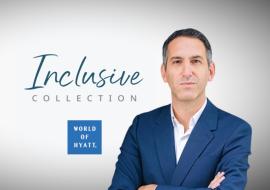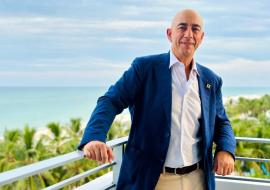Dr. Roberto Morales Ojeda, Cuba’s Minister of Public Health

“Health for All” Scientific & Commercial Fair, together with Cuba Saud 2015 International Convention, got underway Monday in Havana, this time around with major turnouts of Cuban and foreign specialists, companies, pharmaceutical firms and experts. Caribbean News Digital sat down with Cuba’s Public Health Minister, Dr. Roberto Morales Ojeda, who talked about the fair, current and future developments, and the many challenges on the road ahead.
What are the utmost challenges to be presently faced by Cuba’s healthcare system?
Among the main challenges we have the population aging. The average life expectancy is 78.45 years (76.5 for men and 80.45 for women). 19 percent of the population is older than 60 years of age and the projections reveal that this population group will climb to 30 percent by 2030, which is going to bring about the increase of cardiovascular diseases, cancer, diabetes, Alzheimer disease, osteodegenerative processes, disability, among other elements, thus requiring more attention as those are chronic diseases that require more complex and expensive attention on a permanent basis.
Non-transmissible chronic diseases also pose a challenge as they account for the main causes of death in our country. The list includes malign tumors, heart conditions, cerebrovascular diseases and accidents. Habits and lifestyles, obesity, sedentary lifestyles and the habit of smoking, among others, are factors that make people suffer from these diseases, so the approach has to be individual, social and institutional.
Our country, just like the rest of the world, is being hit hard by climate change. Over the years we’ve felt raising temperatures, modification of rainfall cycles, which have an impact on people’s health, specifically in terms of transmissible diseases. The Cuban government recognizes, on the Republic’s Constitution, the need and importance of environmental protection and natural resources, so it features a Comprehensive Program to Cope with Climate Change. Nevertheless, there is a long way to go in this respect, so this work is labeled as a top priority.
While for millions of children living to be five years old is a health challenge, we work to maintain or keep on reducing children’s mortality rate of 4.2 per a thousand living newborns and 99.4 percent survival to the age of five, and that’s the reason why the Cuban Revolution has given priority to health care actions related to women and children.
In an effort to fulfill these goals, Cuba’s Public Healthcare System is undergoing a process of necessary transformations aimed at improving the people’s health, increasing the quality and satisfaction related to the services provided, and making the system efficient and sustainable, thus guaranteeing its development.
What are the prospects of our healthcare system within the framework of the reestablishment of bilateral relations between the governments of Cuba and the United States?
Since the announcement issued on December 17, 2014, by presidents Raul Castro and Barack Obama on the beginning of talks to reestablish diplomatic relations between both countries, an important step we hope the US government can take, by means of passage in Congress, is the lifting of the embargo on Cuba, which has entailed for our Healthcare System the loss of over $66.5 billion, though we cannot accurately calculate the impact on the health of patients that would have had the possibility to benefit from the use of medications and cutting-edge technologies in this field, because we are not allowed to buy products and equipment that have over 10 percent of components produced in the U.S.
We collaborate with other countries when it comes to dealing with natural disasters and epidemic outbreaks.
Another aspect is represented by the academic exchange to be established between our scientific communities, so as to share breakthroughs and experiences between the two sides; just to mention three examples.
A lot has been said about the Cuban Medical Mission in different parts of the planet in providing services and improving international health levels. There are many comments to make in terms of repercussions and contributions. How is the contribution of this Mission to Cuba’s Healthcare System?
Internationalism is a historic tradition of our people and the healthcare sector has been characterized by this principle since the triumph of the Cuban Revolution, since the 1960s when Cuba sent the first medical brigade help Chile deal with the 1962 earthquake, and then in 1962 when authorities announced the arrival of the first medical brigade in Algeria.
Those first collaboration actions were followed by many others in the 1970s and 1980s, with the engagement in pro-independence processes in Ethiopia, Angola and Namibia, all in the 1990s in Africa, and Central America and the Caribbean in 1998 in the aftermaths of hurricanes George and Mitch.
The inauguration of the Latin American School of Medicine was succeeded by different programs, such as the development of the Comprehensive Agreement with Venezuela, Operation Miracle, the creation of the “Henry Reeve” International Brigade of Physicians Specialized in Disasters and Epidemic Outbreaks, the new program of doctor training, bio-psychosocial clinical and genetic study of disabled people and the recent Brazil program called More Doctors.
All those solidary actions have been carried out by over 325,000 healthcare specialists in 158 countries, most of which have participated in more than one mission for a grand total of 595,400 missions.
Workers in our healthcare system, women and men of this country, bring hope and life to other people that need them, with the premise of sharing what we have. They go to the most faraway places in other countries, thus strengthening their values of hard work, altruism and commitment; and they work in the most difficult places to save lives, and that makes them humanely and professionally richer.
It’s very important to highlight the work of the members of Henry Reeve Brigade, who are fighting back the Ebola outbreak in West Africa, putting their own lives on the line as the highest expression of human solidarity.
After the 6th Congress of the Communist Party and the implementation of the Guidelines for the Economic and Social Policy of the Party and the Cuban Revolution, the medical collaboration has been laid out in three tiers: Comprehensive Healthcare Program for countries with low incomes, so Cuba covers all expenses; Comprehensive Healthcare Program with expense compensation for those countries that can cover part of the spending, and the exportation of services to countries that can afford it, which generates incomes that help maintain our healthcare system and bankroll the collaboration with those countries in which Cuba covers part of the expenses or all of them.
The gap between the number of professionals linked to the healthcare system (doctors, nurses, technicians, etc.) and the growth of the world population is getting statistically bigger. What is Cuba’s reality in this matter and what is its international contribution?
After the triumph of the Revolution, nearly fifty percent of the 6,000 doctors that were based in the main cities left for the United States and there was only one school of medicine. The training of human resources has been a priority to the development of our healthcare system, which presently counts on 13 universities of medical sciences, two independent colleges and the Latin American School of Medicine, where we not only train professionals for Cuba, but also for the entire world. Some 39,000 doctors from 121 countries have graduated in this school to date.
This reality gives us the possibility to have one doctor for every 130 inhabitants, one dentist for every 671 and one nurse for every 123, with a rate of 7.7 doctors for every 1,000 inhabitants.














